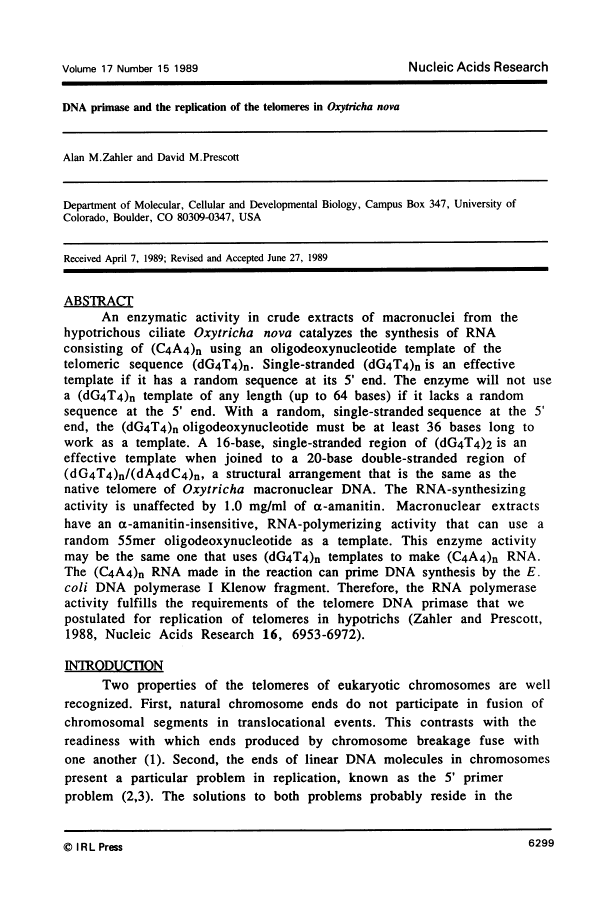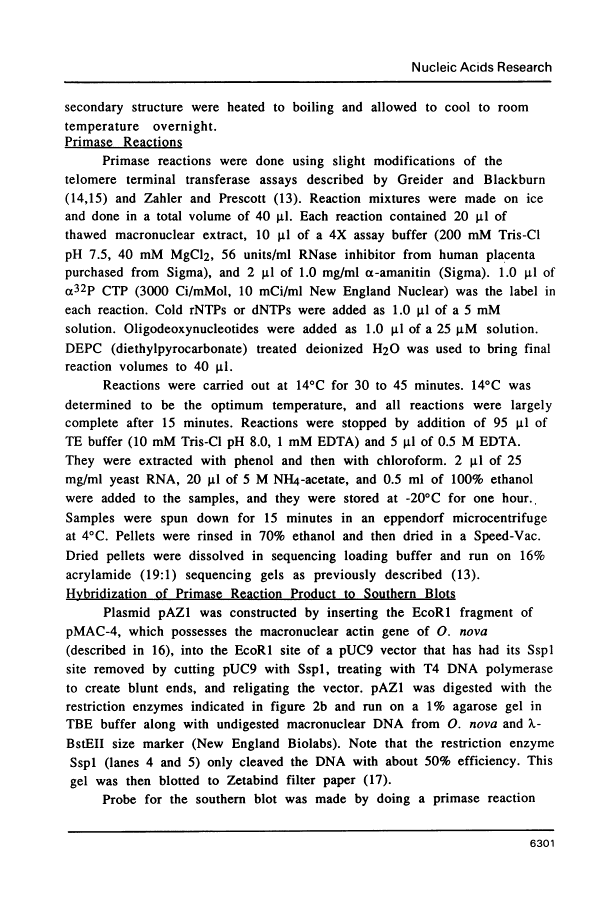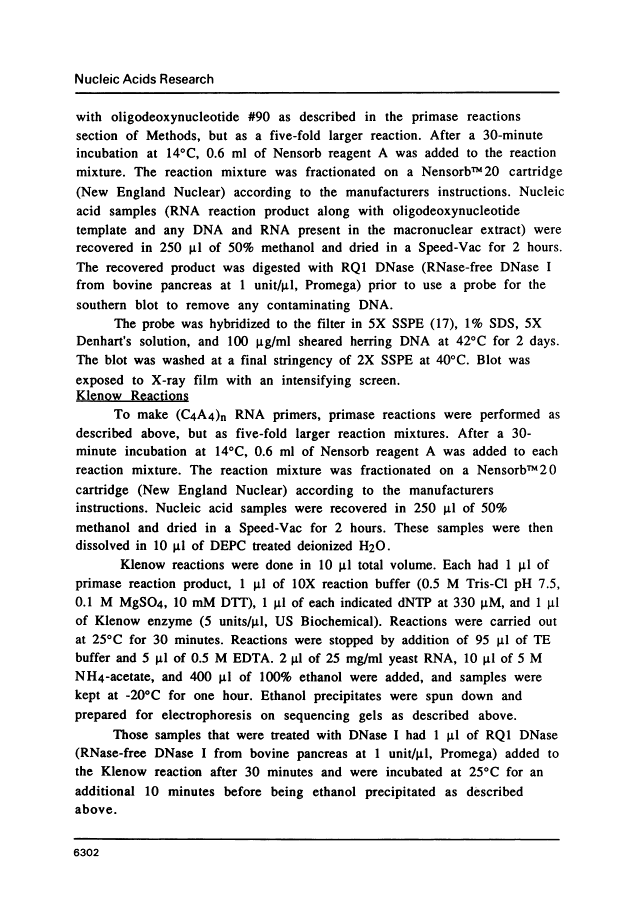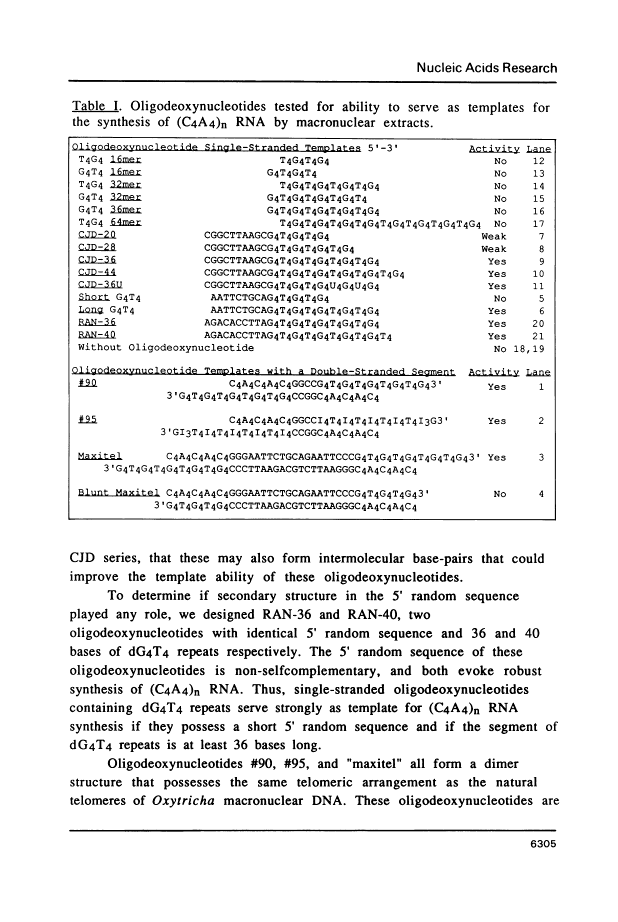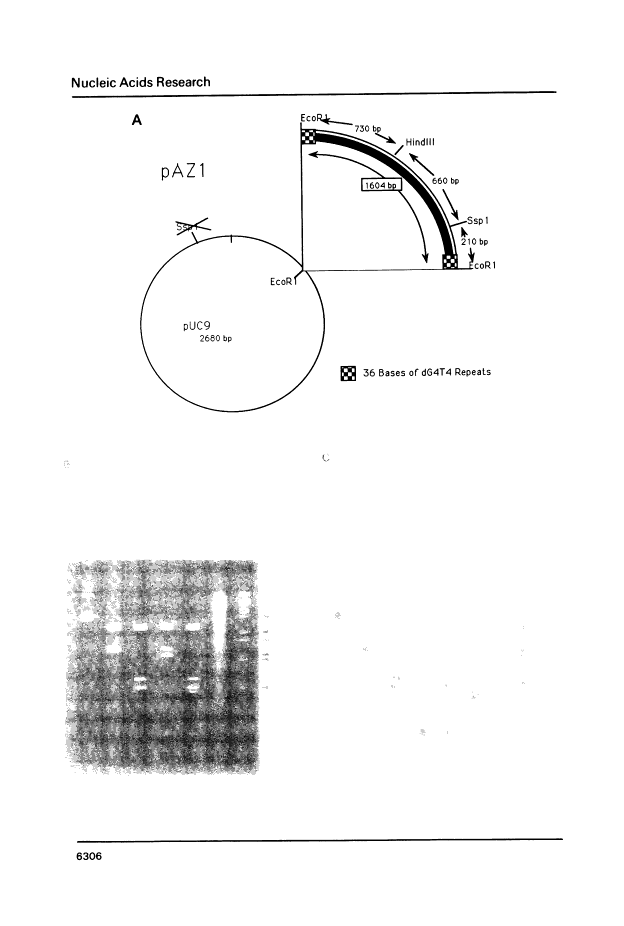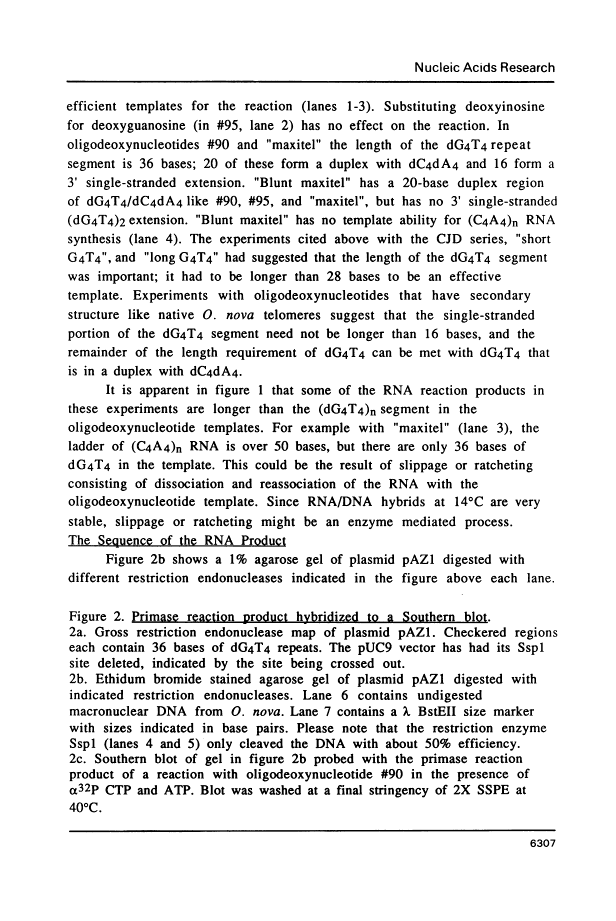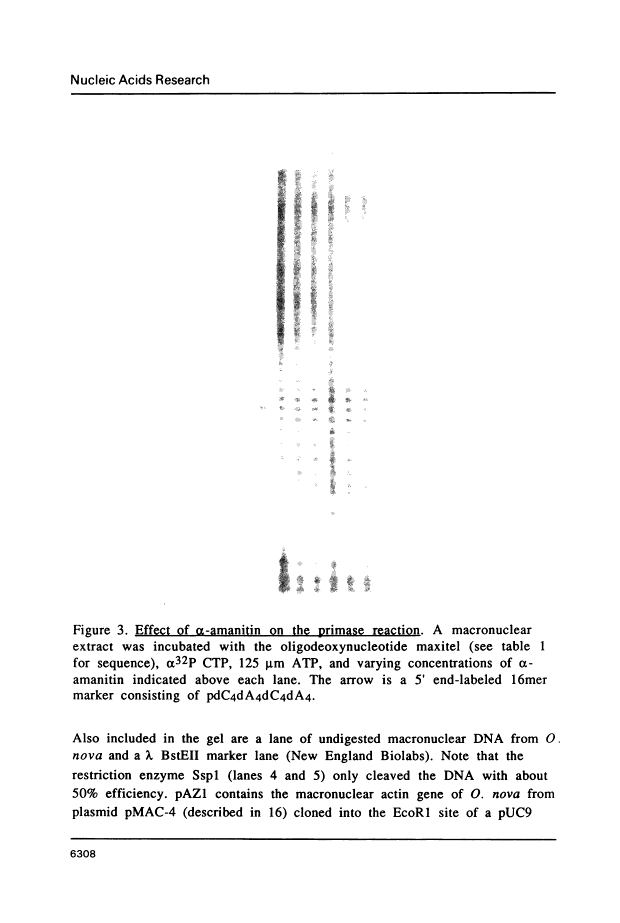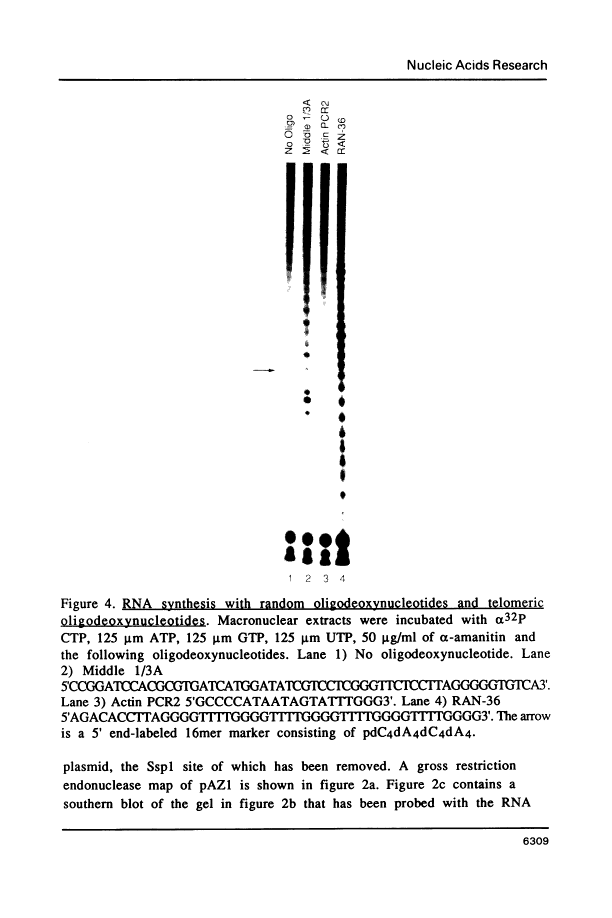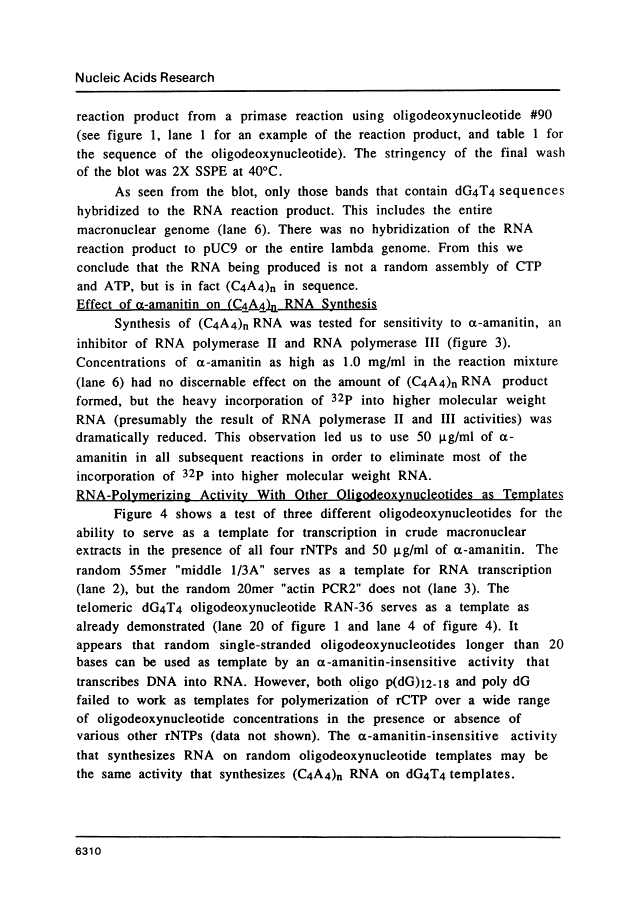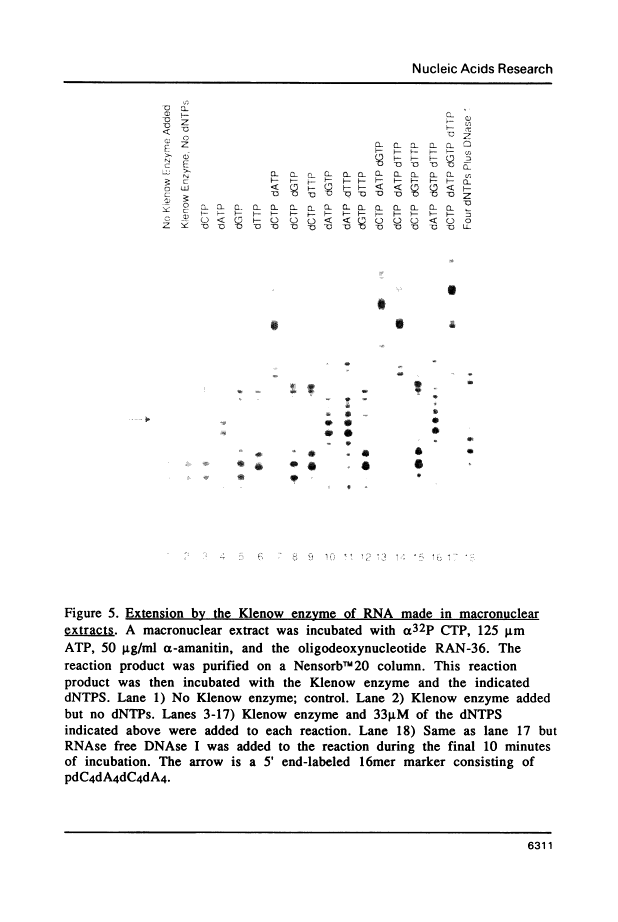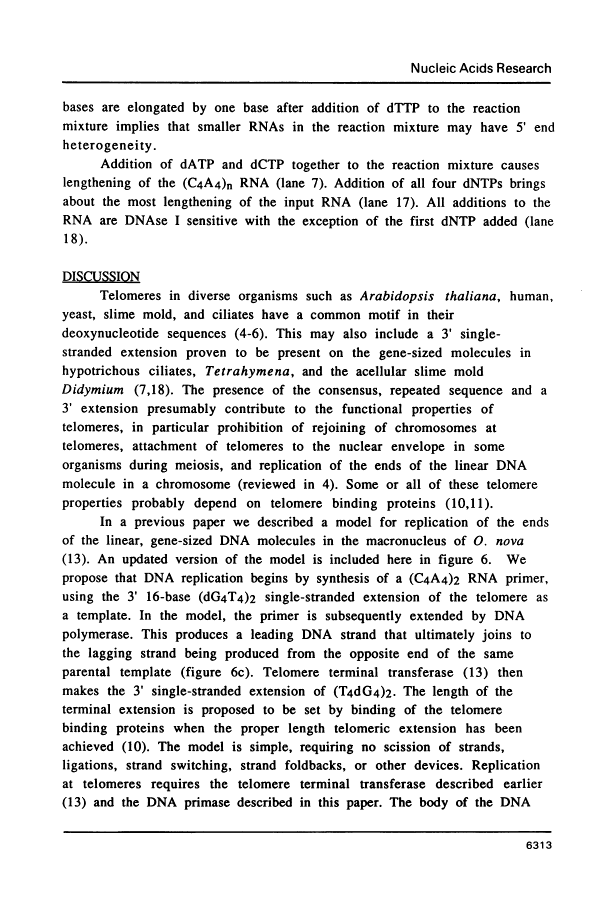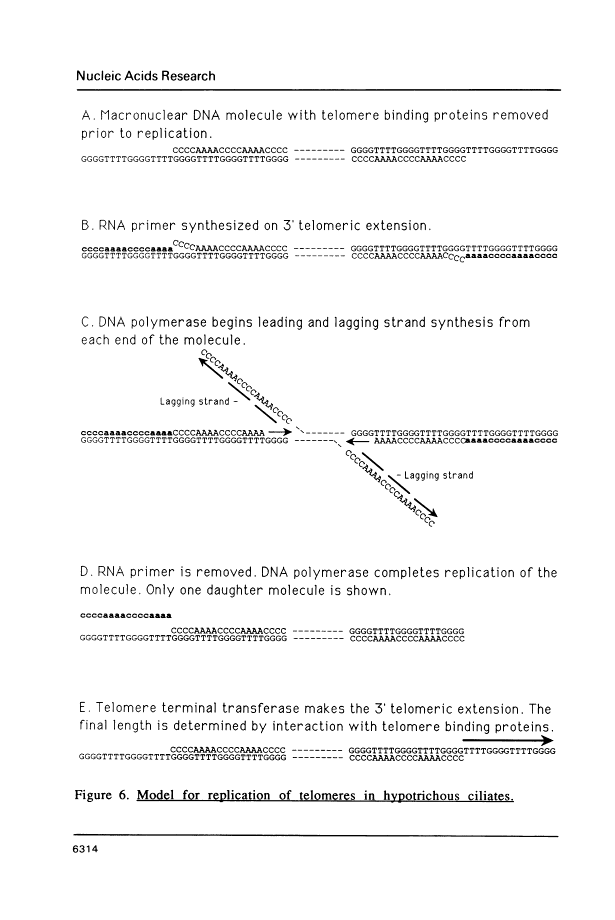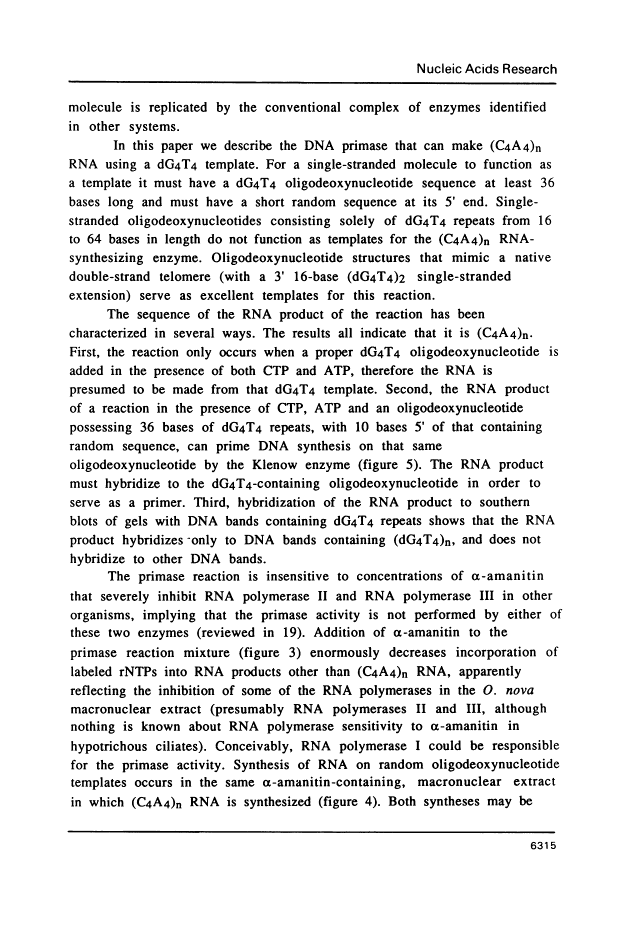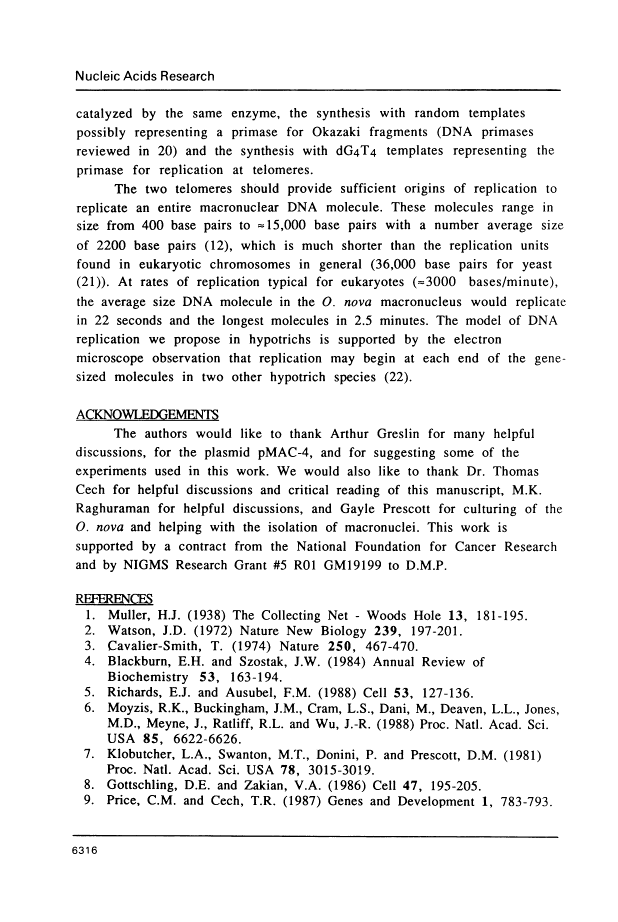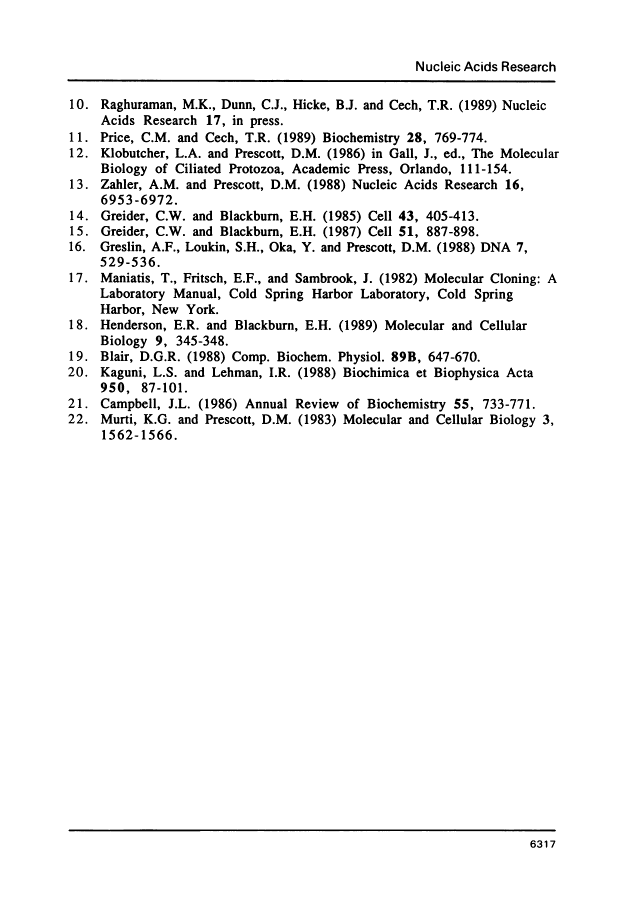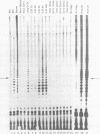Abstract
Free full text

DNA primase and the replication of the telomeres in Oxytricha nova.
Abstract
An enzymatic activity in crude extracts of macronuclei from the hypotrichous ciliate Oxytricha nova catalyzes the synthesis of RNA consisting of (C4A4)n using an oligodeoxynucleotide template of the telomeric sequence (dG4T4)n. Single-stranded (dG4T4)n is an effective template if it has a random sequence at its 5' end. The enzyme will not use a (dG4T4)n template of any length (up to 64 bases) if it lacks a random sequence at the 5' end. With a random, single-stranded sequence at the 5' end, the (dG4T4)n oligodeoxynucleotide must be at least 36 bases long to work as a template. A 16-base, single-stranded region of (dG4T4)2 is an effective template when joined to a 20-base double-stranded region of (dG4T4)n/(dA4dC4)n, a structural arrangement that is the same as the native telomere of Oxytricha macronuclear DNA. The RNA-synthesizing activity is unaffected by 1.0 mg/ml of alpha-amanitin. Macronuclear extracts have an alpha-amanitin-insensitive, RNA-polymerizing activity that can use a random 55mer oligodeoxynucleotide as a template. This enzyme activity may be the same one that uses (dG4T4)n templates to make (C4A4)n RNA. The (C4A4)n RNA made in the reaction can prime DNA synthesis by the E. coli DNA polymerase I Klenow fragment. Therefore, the RNA polymerase activity fulfills the requirements of the telomere DNA primase that we postulated for replication of telomeres in hypotrichs (Zahler and Prescott, 1988, Nucleic Acids Research 16, 6953-6972).
Full text
Full text is available as a scanned copy of the original print version. Get a printable copy (PDF file) of the complete article (2.1M), or click on a page image below to browse page by page. Links to PubMed are also available for Selected References.
Images in this article
Click on the image to see a larger version.
Selected References
These references are in PubMed. This may not be the complete list of references from this article.
- Watson JD. Origin of concatemeric T7 DNA. Nat New Biol. 1972 Oct 18;239(94):197–201. [Abstract] [Google Scholar]
- Cavalier-Smith T. Palindromic base sequences and replication of eukaryote chromosome ends. Nature. 1974 Aug 9;250(5466):467–470. [Abstract] [Google Scholar]
- Richards EJ, Ausubel FM. Isolation of a higher eukaryotic telomere from Arabidopsis thaliana. Cell. 1988 Apr 8;53(1):127–136. [Abstract] [Google Scholar]
- Moyzis RK, Buckingham JM, Cram LS, Dani M, Deaven LL, Jones MD, Meyne J, Ratliff RL, Wu JR. A highly conserved repetitive DNA sequence, (TTAGGG)n, present at the telomeres of human chromosomes. Proc Natl Acad Sci U S A. 1988 Sep;85(18):6622–6626. [Europe PMC free article] [Abstract] [Google Scholar]
- Klobutcher LA, Swanton MT, Donini P, Prescott DM. All gene-sized DNA molecules in four species of hypotrichs have the same terminal sequence and an unusual 3' terminus. Proc Natl Acad Sci U S A. 1981 May;78(5):3015–3019. [Europe PMC free article] [Abstract] [Google Scholar]
- Gottschling DE, Zakian VA. Telomere proteins: specific recognition and protection of the natural termini of Oxytricha macronuclear DNA. Cell. 1986 Oct 24;47(2):195–205. [Abstract] [Google Scholar]
- Price CM, Cech TR. Telomeric DNA-protein interactions of Oxytricha macronuclear DNA. Genes Dev. 1987 Oct;1(8):783–793. [Abstract] [Google Scholar]
- Price CM, Cech TR. Properties of the telomeric DNA-binding protein from Oxytricha nova. Biochemistry. 1989 Jan 24;28(2):769–774. [Abstract] [Google Scholar]
- Zahler AM, Prescott DM. Telomere terminal transferase activity in the hypotrichous ciliate Oxytricha nova and a model for replication of the ends of linear DNA molecules. Nucleic Acids Res. 1988 Jul 25;16(14B):6953–6972. [Europe PMC free article] [Abstract] [Google Scholar]
- Greider CW, Blackburn EH. Identification of a specific telomere terminal transferase activity in Tetrahymena extracts. Cell. 1985 Dec;43(2 Pt 1):405–413. [Abstract] [Google Scholar]
- Greider CW, Blackburn EH. The telomere terminal transferase of Tetrahymena is a ribonucleoprotein enzyme with two kinds of primer specificity. Cell. 1987 Dec 24;51(6):887–898. [Abstract] [Google Scholar]
- Greslin AF, Loukin SH, Oka Y, Prescott DM. An analysis of the macronuclear actin genes of Oxytricha. DNA. 1988 Oct;7(8):529–536. [Abstract] [Google Scholar]
- Henderson ER, Blackburn EH. An overhanging 3' terminus is a conserved feature of telomeres. Mol Cell Biol. 1989 Jan;9(1):345–348. [Europe PMC free article] [Abstract] [Google Scholar]
- Blair DG. Eukaryotic RNA polymerases. Comp Biochem Physiol B. 1988;89(4):647–670. [Abstract] [Google Scholar]
- Kaguni LS, Lehman IR. Eukaryotic DNA polymerase-primase: structure, mechanism and function. Biochim Biophys Acta. 1988 Jul 13;950(2):87–101. [Abstract] [Google Scholar]
- Campbell JL. Eukaryotic DNA replication. Annu Rev Biochem. 1986;55:733–771. [Abstract] [Google Scholar]
- Murti KG, Prescott DM. Replication forms of the gene-sized DNA molecules of hypotrichous ciliates. Mol Cell Biol. 1983 Sep;3(9):1562–1566. [Europe PMC free article] [Abstract] [Google Scholar]
Associated Data
Articles from Nucleic Acids Research are provided here courtesy of Oxford University Press
Full text links
Read article at publisher's site: https://doi.org/10.1093/nar/17.15.6299
Read article for free, from open access legal sources, via Unpaywall:
https://europepmc.org/articles/pmc318279?pdf=render
Citations & impact
Impact metrics
Citations of article over time
Smart citations by scite.ai
Explore citation contexts and check if this article has been
supported or disputed.
https://scite.ai/reports/10.1093/nar/17.15.6299
Article citations
Programmed chromosome fragmentation in ciliated protozoa: multiple means to chromosome ends.
Microbiol Mol Biol Rev, 87(4):e0018422, 27 Nov 2023
Cited by: 2 articles | PMID: 38009915
Review
Mating of the stichotrichous ciliate Oxytricha trifallax induces production of a class of 27 nt small RNAs derived from the parental macronucleus.
PLoS One, 7(8):e42371, 10 Aug 2012
Cited by: 36 articles | PMID: 22900016 | PMCID: PMC3416858
How telomeres are replicated.
Nat Rev Mol Cell Biol, 8(10):825-838, 01 Oct 2007
Cited by: 279 articles | PMID: 17885666
Review
Sequence features of Oxytricha trifallax (class Spirotrichea) macronuclear telomeric and subtelomeric sequences.
Protist, 155(3):311-322, 01 Sep 2004
Cited by: 19 articles | PMID: 15552058
Interactions between telomerase and primase physically link the telomere and chromosome replication machinery.
Mol Cell Biol, 22(16):5859-5868, 01 Aug 2002
Cited by: 34 articles | PMID: 12138196 | PMCID: PMC133977
Go to all (22) article citations
Similar Articles
To arrive at the top five similar articles we use a word-weighted algorithm to compare words from the Title and Abstract of each citation.
Telomere terminal transferase activity in the hypotrichous ciliate Oxytricha nova and a model for replication of the ends of linear DNA molecules.
Nucleic Acids Res, 16(14b):6953-6972, 01 Jul 1988
Cited by: 107 articles | PMID: 3136437 | PMCID: PMC338344
RNA priming coupled with DNA synthesis on natural template by calf thymus DNA polymerase alpha-primase.
Biochemistry, 32(47):12782-12792, 01 Nov 1993
Cited by: 16 articles | PMID: 7504526
Bal31 sensitivity of micronuclear sequences homologous to C4A4/G4T4 repeats in Oxytricha nova.
Exp Cell Res, 177(1):162-175, 01 Jul 1988
Cited by: 8 articles | PMID: 2839349
The genome of hypotrichous ciliates.
Int Rev Cytol, 99:1-28, 01 Jan 1986
Cited by: 27 articles | PMID: 3082786
Review
